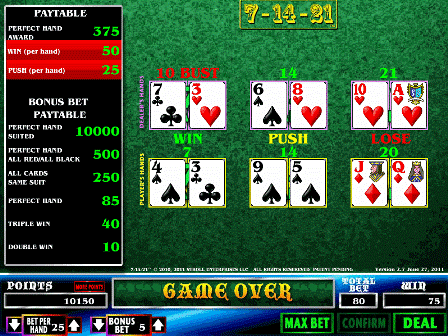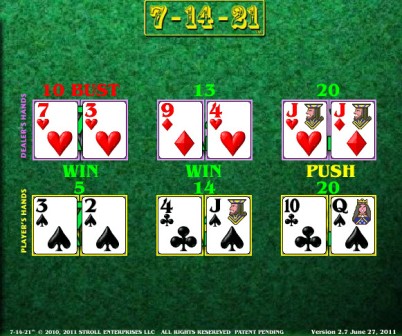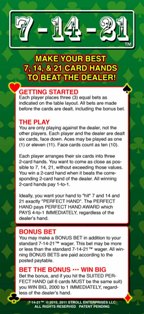On this page
7-14-21
Introduction
7-14-21 is a table game I first noticed at the Palms in the summer of 2011. Previously it was played at the Grand Biloxi in late 2010.
It is hard to compare 7-14-21 to any other game. If forced, it is like a combination of pai gow poker and blackjack. The strategy is quite easy, the pace is slow, and the volatility is very low. With optimal strategy the house edge is 0.54%, which is very low for a new game. For players looking for an easy game where your money lasts a long time it would be hard to beat 7-14-21.
Rules
- A single 52-card deck is used.
- All cards scored as in blackjack.
- Player makes three equal bets, plus optional Bonus Bet.
- Player and dealer each get six cards.
- Player arranges his cards into three 2-cards hands, titled 7, 14, and 21.
- The object of each hand is to get as close to the indicated number of points without going over.
- After the players have set their hands the dealer will set his according to the house way.
- The player's 21 hand is compared to the dealer's 21 hand. The one closer to 21 wins.
- The player's 14 hand is compared to the dealer's 14 hand. The one closer to 14, without going over, wins. If both go over, then the dealer wins.
- The player's 7 hand is compared to the dealer's 7 hand. The one closer to 7, without going over wins. If both go over, then the dealer wins.
- The 14 and 7 hands are scored in the same manner as the 21 hand.
- Wins pay even money, and ties push.
- In the event the player makes a "perfect hand," which is exactly 7, 14, and 21 points, he is automatically paid 4 to 1 on all three wagers, regardless of the dealer's cards.
House Way
Dealer first makes the best 21 hand possible. Dealer then makes the best 14 hand possible. If there is more than one way to make 14 points the dealer will chose the way with the fewest aces.
Bonus Bet
The following table shows the pay table for the Bonus Bet. All wins are on a "to one" basis, meaning the player gets his Bonus Bet back if he wins.
Bonus Bet Pay Table
| Event | Pays |
|---|---|
| Suited perfect hand | 2000 |
| Colored perfect hand | 100 |
| All cards same suit | 50 |
| Perfect hand | 16 |
| Beat the dealer on all three hands | 7 |
| Win any two hands | 1 |
Example
Here is an example from the 7-14-21 free demo game. I bet $25 each on the 7, 14, and 21 hands, and $5 on the Bonus Bet.
I won the "7" bet, because the dealer went over 7, and I did not. I pushed the "14" bet, because both of us had 14 points. I lost the "21" bet, because my 20 lost to the dealer's 21. I also lost the Bonus Bet. So my $80 returned $75, for a net loss of $5. Such win-push-loss outcomes are common in this game.
Rack Card Strategy
The rack card suggests the following strategy, in order of priority:
- Bust as few hands as possible.
- Maximize value of "7" hand.
- Maximize value of "14" hand.
Following this strategy literally results in a house edge of 7.78%. Astute players will likely make some adjustments with aces, to get an extra 10 points out of the ace.
Power Rating Strategy
The following table shows how often the dealer will make each total in each hand. Note that the dealer makes the top hand 35% of the time on the "21," and 36% on the 14. This illustrates how you should try to go for the top hands, if you can.
"miplet" Table of Dealer Probabilities
| Points | 7 Hand | 14 Hand | 21 Hand |
|---|---|---|---|
| 21 | 0.346067 | ||
| 20 | 0.425151 | ||
| 19 | 0.095137 | ||
| 18 | 0.057718 | ||
| 17 | 0.035375 | ||
| 16 | 0.018762 | ||
| 15 | 0.010607 | ||
| 14 | 0.362775 | 0.005173 | |
| 13 | 0.255736 | 0.003081 | |
| 12 | 0.157870 | 0.001511 | |
| 11 | 0.084130 | 0.000858 | |
| 10 | 0.042205 | 0.000348 | |
| 9 | 0.028119 | 0.000156 | |
| 8 | 0.015282 | 0.000044 | |
| 7 | 0.078602 | 0.009065 | 0.000011 |
| 6 | 0.079235 | 0.003164 | 0.000001 |
| 5 | 0.090122 | 0.000791 | |
| 4 | 0.048220 | 0.000055 | |
| 3 | 0.002876 | ||
| 2 | 0.000647 | ||
| Bust | 0.700298 | 0.040807 | |
| Total | 1.000000 | 1.000000 | 1.000000 |
The next table transforms the above probabilities into a a power rating from 0 to 10 for each score for each hand. To estimate the best way to play any given hand look up all viable ways to play it, and go with the way with the most points. If two or more options are tied for the best, then go with the one that maximizes the "21" first, and then the "14."
Power Rating Table
| Points | 7 Hand | 14 Hand | 21 Hand |
|---|---|---|---|
| 21 | 8 | ||
| 20 | 4 | ||
| 19 | 2 | ||
| 18 | 1 | ||
| 17 | 0 | ||
| 16 | 0 | ||
| 15 | 0 | ||
| 14 | 8 | 0 | |
| 13 | 5 | 0 | |
| 12 | 3 | 0 | |
| 11 | 2 | 0 | |
| 10 | 1 | 0 | |
| 9 | 1 | 0 | |
| 8 | 1 | 0 | |
| 7 | 10 | 0 | 0 |
| 6 | 9 | 0 | 0 |
| 5 | 8 | 0 | |
| 4 | 7 | 0 | |
| 3 | 7 | ||
| 2 | 7 | ||
| Bust | 0 | 0 |
Following is an example hand showing how to use the power rating table.
The rack card strategy would have the player playing 7-12-20, for a total of 10+3+4=17 power rating points. However, 5-14-20 maximizes the power ratings with 8+8+4=20 points. In other words, the two points you give up on the "7" hand, gives you a lot more on the "14" hand in this situation. This turned out to be a good decision. Either way I would have won on the "7" and pushed on the "21," but going from 12 to 14 on the "14" turned a loss into a win. Overall, the house edge on the power rating strategy is 0.59%.
Optimal Strategy
With the exception of spreadsheets showing all 4,915 hands, nobody has ever quantified optimal strategy in writing, at least that I am aware of. However, we know a lot about the results of it. The following three tables show the probabilities and returns for the 7, 14, 21 hands respectively, assuming optimal strategy and no Bonus Bet. The lower right cells show a player advantage of 10.61% on the "7" bet, 5.55% on the "14," and -17.78% on the "21."
"7" Hand Return Table
| Event | Pays | Combinations | Probability | Return |
|---|---|---|---|---|
| Perfect Hand | 4 | 1,326,041,832,192 | 0.006954 | 0.027815 |
| Win | 1 | 98,351,547,179,402 | 0.515754 | 0.515754 |
| Push | 0 | 7,594,548,011,854 | 0.039826 | 0.000000 |
| Loss | -1 | 83,422,434,924,432 | 0.437466 | -0.437466 |
| Total | 190,694,571,947,880 | 1.000000 | 0.106103 |
"14" Hand Return Table
| Event | Pays | Combinations | Probability | Return |
|---|---|---|---|---|
| Perfect Hand | 4 | 1,326,041,832,192 | 0.006954 | 0.027815 |
| Win | 1 | 75,239,808,955,794 | 0.394557 | 0.394557 |
| Push | 0 | 44,164,023,505,252 | 0.231596 | 0.000000 |
| Loss | -1 | 69,964,697,654,642 | 0.366894 | -0.366894 |
| Total | 190,694,571,947,880 | 1.000000 | 0.055478 |
"21" Hand Return Table
| Event | Pays | Combinations | Probability | Return |
|---|---|---|---|---|
| Perfect Hand | 4 | 1,326,041,832,192 | 0.006954 | 0.027815 |
| Win | 1 | 51,808,306,547,303 | 0.271682 | 0.271682 |
| Push | 0 | 46,544,958,204,077 | 0.244081 | 0.000000 |
| Loss | -1 | 91,015,265,364,308 | 0.477283 | -0.477283 |
| Total | 190,694,571,947,880 | 1.000000 | -0.177786 |
The next table summarizes the odds for the three bets under optimal strategy, assuming no Bonus Bet. The lower right cell shows an overall house edge of 0.54%.
7-14-21 Optimal Strategy Return Table
| Hand | Perfect Hand |
Win | Push | Loss | Expected Value |
|---|---|---|---|---|---|
| 7 | 0.006954 | 0.515754 | 0.039826 | 0.437466 | 0.106103 |
| 14 | 0.006954 | 0.394557 | 0.231596 | 0.366894 | 0.055478 |
| 21 | 0.006954 | 0.271682 | 0.244081 | 0.477283 | -0.177786 |
| Average | 0.006954 | 0.393998 | 0.171834 | 0.427214 | -0.005402 |
The following table shows the probability and return for each event for the Bonus Bet, assuming optimal strategy and the Bonus Bet is equal to any one of the three 7-14-21 wagers.
Bonus Bet Return Table
| Event | Pays | Combinations | Probability | Return |
|---|---|---|---|---|
| Same suit perfect hand | 2000 | 674,410,968 | 0.000004 | 0.007073 |
| Same color perfect hand | 100 | 33,196,006,536 | 0.000174 | 0.017408 |
| Fully suited hand | 50 | 63,619,434,648 | 0.000334 | 0.016681 |
| Perfect hand | 16 | 1,292,171,414,688 | 0.006776 | 0.108418 |
| Triple winner | 7 | 4,345,719,498,180 | 0.022789 | 0.159522 |
| Double winner | 1 | 60,554,492,338,178 | 0.317547 | 0.317547 |
| No bonus | -1 | 124,404,698,844,682 | 0.652377 | -0.652377 |
| Total | 0 | 190,694,571,947,880 | 1.000000 | -0.025727 |
Unlike most table games, in 7-14-21 the player's actions determine the outcome of the Bonus side bet. In some borderline cases, this will cause the player to deviate from the optimal strategy for the base game. The greater the ratio of the Bonus Bet to the 7, 14, and 21 bets, the more the player will try to win the Bonus Bet, at the expense of the other three.
The following table shows the expected return of all four bets according to the ratio of the Bonus Bet to any single 7, 14, or 21 wager. The left column shows this ratio. For example, if the player bet $5 on each of the 7, 14, and 21 wagers, and $1 on the Bonus Bet, then his ratio would be $1/$5=0.2. That row shows a combined house edge on the 7-14-21 bets of 0.547%, and 0.690% on all bets combined.
Combined Return Table
| Ratio | "7" Bet | "14" Bet | "21" Bet | Bonus Bet | 7-14-21 Combined |
All Bets Combined |
|---|---|---|---|---|---|---|
| 0 | 0.106103 | 0.055478 | -0.177786 | 0.000000 | -0.005402 | -0.005402 |
| 0.2 | 0.099452 | 0.061278 | -0.177128 | -0.028348 | -0.005466 | -0.006896 |
| 1 | 0.090406 | 0.072930 | -0.181177 | -0.025727 | -0.005947 | -0.010892 |
House Edge Summary
The following table summarizes the house edge of the three strategies discussed here, assuming no strategy deviations caused by the Bonus Bet.
House Edge Summary
| Strategy | House Edge |
|---|---|
| Optimal | 0.54% |
| Power Rating | 0.59% |
| Rack Card | 7.78% |
Rack Card
Acknowledgements
I'd like to thank the following people for their contributions to this page.
- Stroll Enterprises, the game owners, for their math, photos, and images of the game.
- miplet and CrystalMath for the dealer probabilities table and most of the work behind the Power Rating strategy.
Outside Links
- Official 7-14-21 web site from the game maker. Includes an outstanding free demo game.
- Forum discussion on 7-14-21 at WizardOfVegas.com.





